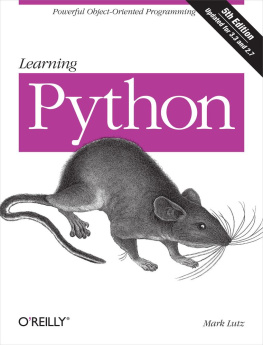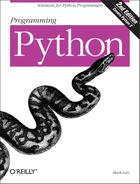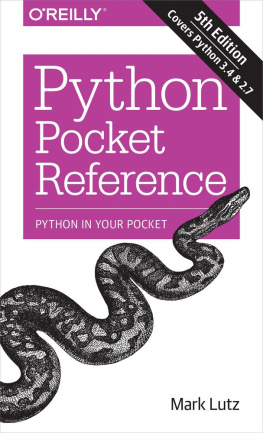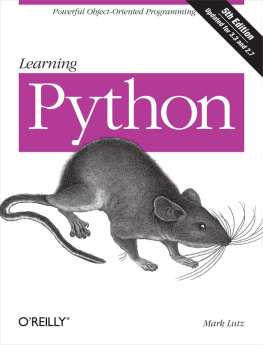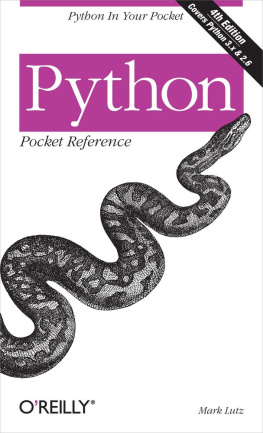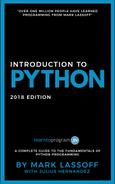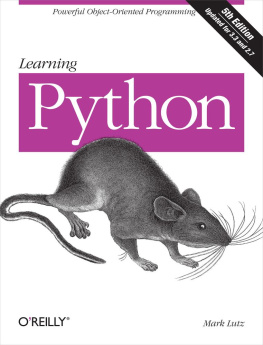On the language front, this edition has been thoroughly updated to reflect Python 2.5 and all changes to the language since the publication of the second edition. (The second edition was based largely on Python 2.2, with some 2.3 features grafted on at the end of the project.) In addition, discussions of anticipated changes in the upcoming Python 3.0 release have been incorporated where appropriate. Here are some of the major language topics of which you'll find new or expanded coverage in this edition:
This Edition's Python Training Changes
Besides such language changes, this edition has been augmented with new topics and examples presented in the Python training sessions I have held in recent years. For example, you'll find:
A new chapter introducing built-in types ().
A new chapter introducing statement syntax ().
A new full chapter on dynamic typing, with enhanced coverage ().
An expanded OOP introduction ().
New examples for files, scopes, statement nesting, classes, exceptions, and more.
Many additions and changes were made with Python beginners in mind, and some topics have been moved to appear at the places where they have proved simplest to digest in training classes. List comprehensions and iterators, for example, now make their initial appearance in conjunction with the for loop statement, instead of later with functional tools.
You'll also find that the coverage of many original core language topics has been substantially expanded in this edition, with new discussions and examples added. Because this text has become something of a de facto standard resource for learning the core Python language, the presentation has been made more complete and augmented with new use cases throughout.
In addition, this entire edition integrates a new set of Python tips and tricks, gleaned from teaching classes during the last 10 years, and using Python for real work over the last 15. The exercises have also been updated and expanded to reflect current Python best practices, new language features, and common beginners' mistakes witnessed firsthand in classes. Overall, the core language coverage provided by this edition is larger than in previous editions, both because Python is larger, and because I've added contextual information that has proved to be important in practice.
This Edition's Structural Changes
As in the prior edition, to accommodate the fact that this book is now more complete, its material has been split into bite-sized chunks. That is, I've organized the core language material into many multichapter parts to make the material easier to tackle. Types and statements, for instance, are now two top-level parts, with one chapter for each major type and statement topic. This new structure is designed to allow the book to say more without intimidating readers. In the process, exercises and "gotchas" (common mistakes) were moved from chapter ends to part endsthey now appear at the end of the last chapter in each part.
In this third edition, I've also augmented the end-of-part exercises with end-of-chapter summaries and end-of-chapter quizzes to help you review chapters as you complete them. Each chapter concludes with a set of questions to help you review and test your understanding of the chapter's material. Unlike the end-of-part exercises, whose solutions are presented in , the solutions to the end-of-chapter quizzes appear immediately after the questions; I encourage you to look at the solutions even if you're sure you've answered the questions correctly because the answers are a sort of review in themselves.
Despite all the new topics, this book is still oriented toward Python newcomers, and is designed to be a first Python text for programmers.[] It retains much of the first two editions' material, structure, and focus. Where appropriate, I've expanded introductions for newcomers, and isolated the more advanced new topics from the main thread of discussion to avoid obscuring the fundamentals. Moreover, because it is largely based on time-tested training experience and materials, this edition, like the first two, can still serve as a self-paced introductory Python class.
This Edition's Scope Changes
This third edition is intended as a tutorial on the core Python language, and nothing else. It's about learning the language in an in-depth fashion, before applying it in application-level programming. The presentation here is bottom-up and gradual, but it provides a complete look at the entire language, in isolation from its application roles.
For some, "learning Python" involves spending an hour or two going through a tutorial on the Web. This works for already advanced programmers up to a point; Python is, after all, relatively simple by comparison to other languages. The problem with this fast-track approach is that its practitioners eventually stumble onto unusual cases and get stuckvariables change out from under them, mutable default arguments mutate inexplicably, and so on. The goal here is instead to provide a solid grounding in Python fundamentals, so that even the unusual cases will make sense when they crop up.


